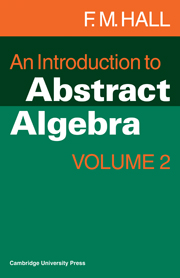10 - GEOMETRICAL APPLICATIONS
Published online by Cambridge University Press: 12 October 2009
Summary
Euclidean geometry
There are several ways of placing the various types of geometry on a rigorous axiomatic footing. One way is by means of purely geometrical axioms: thus projective geometry may be based on axioms of incidence, together with one or two others, such as that postulating the idea of cross-ratio. One very satisfying method is by means of algebra: basing geometry on the idea of a vector space. The connection between a vector space and geometry based on a co-ordinate system is obvious, and since it is easy to define the former abstractly, as in the previous chapter, it is comparatively straightforward to give a rigorous development of a geometry by this means. Such a treatment loses something in beauty—analytical geometry is never as fascinating as pure geometry—but it gains tremendously in the ease with which firm foundations may be laid. In this section we will indicate briefly the formulation of Euclidean geometry by this means, and in the following sections we will apply the method to some other geometries.
Euclidean geometry is a complicated structure, much more so than is, for example, projective geometry. Even if we define lines, planes etc., in terms of linear manifolds in the obvious ways the ideas that we have already introduced about vector spaces are not sufficient for our present purpose. The idea that distinguishes Euclidean geometry, and which we have not so far introduced, is that of distance, and its consequence, the notion of angle.
Information
- Type
- Chapter
- Information
- An Introduction to Abstract Algebra , pp. 273 - 310Publisher: Cambridge University PressPrint publication year: 1969
